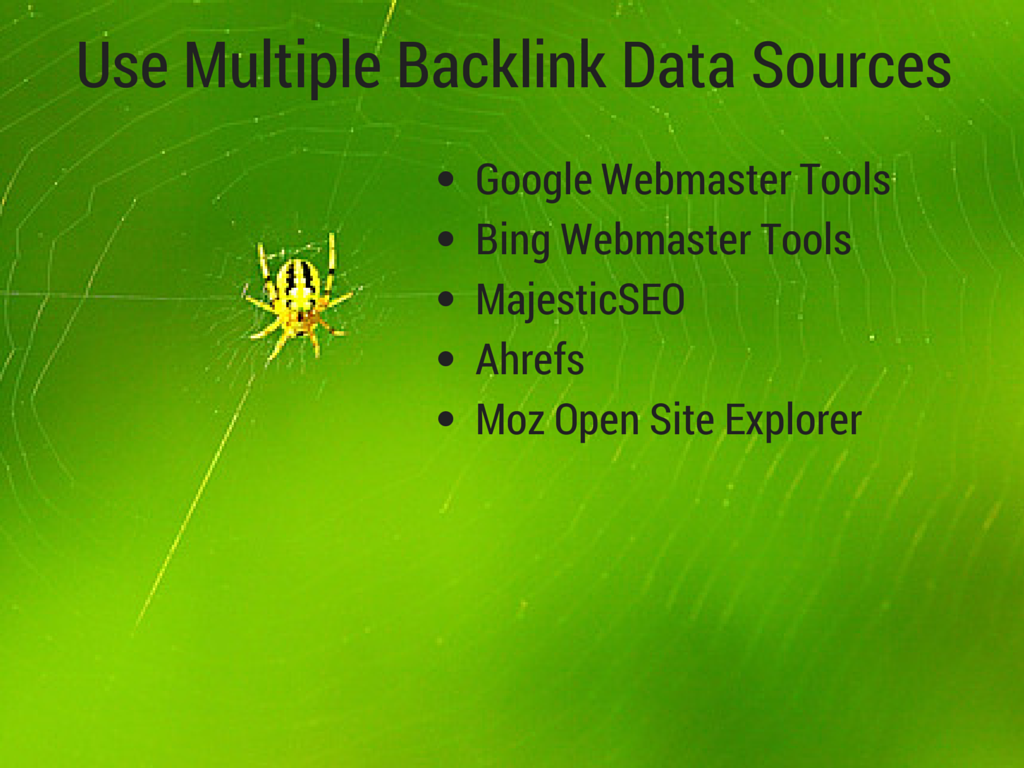9 Tips for Getting Your Manual Link Penalty Overturned
The effect that an unnatural link penalty can have on a website can be crippling. Make no mistake, there is a punitive aspect to these actions. Google is looking to teach webmasters a lesson, one that insures that they will not think about violating the search giant’s quality guidelines in the future. To drive their point home, Google makes the process of recovering from these penalties very difficult.
Link penalty recovery takes time, effort, and a substantial commitment of resources. Depending on your specific situation, you could end up reviewing and/or removing hundreds of thousands (millions?) of links. And generally speaking, there is no shortcut to forgiveness.
A good number of clients that approached our firm for SEO services over the past year came to us suffering from some form of manual or algorithmic penalty. The good news is that we have seen a high degree of success in getting penalties overturned. What follows is a list of tips for getting a specific type of penalty removed: a manual link penalty.
These tips are my own and as such are one analyst’s experiences dealing with these types of specific penalties; every situation is unique, but generally speaking, if you follow these tips, you’ll increase your chances of recovering from the penalty substantially.
1. Removing Links Is Job #1
There’s a reason that this is the first item on the list. If you are suffering from a manual link penalty (or any link penalty, for that matter) your best chance of having it overturned is the removal (or nofollowing) of inorganic links from the Internet. Do not rely on the disavow tool; it’s considered a last resort tool by Google and should only be used when every effort has been made to remove poor backlinks manually.
While Google has never confirmed their exact method of processing reconsideration requests, my experience tells me that one of the main metrics they consider is the amount of live inorganic links that are removed over time.
2. Be Thorough in Your Pruning Effort
The more backlinks you can gather for auditing, the better chance you have of offering Google a complete pruning effort. You should never rely solely on reported backlinks in Google Webmaster Tools. In fact, consider adding a second or third source of links. Bing Webmaster Tools, MajesticSEO, Ahrefs, and Moz’s Open Site Explorer are all excellent sources of backlink data.
There are plenty of stories out there that describe how Google has reported inorganic backlinks in denied reconsideration requests that are not listed in Google Webmaster Tools’ backlink report. It behooves webmasters to make an effort to monitor backlinks and create a more complete list if they hope to recover from a link penalty. If you paid someone to build links in the past, contacting them to try and obtain the original work log that listed the links built can be exceedingly valuable.
You can take this a step further and use Google itself to search for boilerplate language that link builders used to create backlinks to your site. Snippets from articles or searches for forum profile names and descriptions can uncover links that even the backlink reporting services may have missed.
3. Don’t Prune Nofollowed Links
Part of being thorough is making sure that you have gathered all of the pertinent data to assess your link profile. Nofollowed links do not pass PageRank and as such, they do not require removal or disavowing. You’d be shocked by how many clients I have worked with (many of whom run large online listing directories) who have nofollowed all external links on their site, but still receive removal requests.
It is important to note that Google Webmaster Tools does not offer data related to nofollowed or previously disavowed links (Matt Cutts, are you listening?), so you’ll need to crawl the links provided on those pages to gather details about them (Screaming Frog does a great job of this). Most link reporting tools like MajesticSEO, Ahrefs, etc., have a column that indicates if a link is nofollowed or not, but depending on the freshness of that data, the links themselves may not be live, which leads us to #4. . .
4. Make Sure the Links on Your Sheet Are LIVE
Just because a link is being reported by Google Webmaster Tools or another backlink data provider, it doesn’t mean that the link is active and live on the Internet. Depending on when your link report was run, the links in question could be long gone (and so could the site they appeared on). You can automate the process of crawling a list of links to ensure they are live fairly easily using tools like Screaming Frog or SEOTools For Excel.
5. Want Your Link Nofollowed or Removed? Ask Nicely
Some webmasters get inundated with link pruning requests and it’s not because they run a spammy site. Oftentimes their only sin was allowing followed comment links or trackbacks to be published on their site. Put yourself in the shoes of those webmasters when you craft your removal/nofollow request letter. How does the old saying go? “You catch more flies with honey than you do with vinegar”? This certainly applies to removal requests, so when crafting yours, be considerate and professional.
I do want to mention that there are some webmasters out there that will be less than amiable when they respond to your requests. Some will ask for money to remove your links while others will virtually scream, curse, spit and complain about your request. We advise our clients to ignore these responses, preserve their professionalism, and put the offending domains directly into the disavow list.
6. Disavow on the Domain Level
If you do have to resort to disavowing a link or set of links, it is probably better to disavow the entire domain as opposed to the individual URLs. Links that appear on blogs can often be republished on tag or archive pages and those pages aren’t always listed in the backlink report you might be working from. If you’ve decided the links in question have no value and can make the same claim for the entire domain, a domain level disavow is advised.
7. Track and Share Your Work
A proper link pruning spreadsheet details:
- All of the data that you’ve gathered about a link
- Your assessment of the value of that link (and reasoning behind it)
- Your history in trying to get it removed or nofollowed
- And finally the result of those efforts
Keeping vigilant track of this information in one location and then uploading that file to Google Drive to share with the Google engineer who will be reviewing your reconsideration request is vital to getting your penalty removed.
Don’t forget to make sure that anybody with the link to your link pruning spreadsheet can view the entire document. List links to your link pruning spreadsheet in your disavow file and in the text of your reconsideration request as well.
8. Admit Your Sin, Detail Your Penance, Promise to Never Do It Again
The Google webspam team published a set of videos discussing manual action penalties. In them, Matt Cutts repeatedly indicates that there are 3 aspects to getting your manual penalty overturned.
- Give background on how and why you got the penalty
- Detail how you fixed the issue
- Assure the search giant that you will NOT violate their quality guidelines again
The body of your reconsideration request should discuss these 3 points in detail.
Make letters thorough, but also consider hitting these 3 points in the first few paragraphs of the letter. While we would like to think that the Google engineers who review reconsideration requests read every word we write, it makes sense to give them a summary of the work performed early on in the letter.
When crafting reconsideration requests I ask myself this question: If the Google engineer only has time to read the first few paragraphs of this reconsideration request, would they have all of the information they need to overturn the penalty? If they don’t, redraft your letter so they do.
9. Be Patient; Auditing Links Takes Time
If there’s a common theme among failed link pruning campaigns, it’s the reluctance to roll up your sleeves and do the work necessary to fix the problem. Auditing links takes time and there’s no way to fake it. While it is true that you can exclude certain links from review (either because they are clearly valuable or harmful) the vast majority of links will require a website visit and a manual audit.
Unless you are Interflora, Rap Genius, or JCPenney, the process for recovering from a penalty is made intentionally difficult by Google. As I alluded to earlier, there is definitely a punitive aspect to the manual actions – they are intended to make a large enough impact into the health and profitability of a website that the “offending” webmasters think twice before breaking Google’s Quality Guidelines again.
Google has even tweaked their reconsideration request denial letters to indicate that they expect you to spend time pruning links before you submit additional requests. They want to see webmasters put in substantial work in order to recover from these penalties.
Some believe that the first rounds of reconsideration requests are automatically denied. While we have not seen that to necessarily be the case, we do see that denied reconsideration requests all share some common characteristics – most notably quick, sloppy, artificial link pruning efforts that rely heavily on disavowing instead of the very difficult work involved in manually removing the offending links.
Tough Choices and a Word of Warning
The process of link pruning will take time and be an iterative process. Depending on the overall disposition of your link profile, you may have to make some hard decisions about links that may have some value. We see this quite often as clients who engaged in link building, not link earning, campaigns are forced to prune or nofollow links that would ordinarily be considered organic. The decision to do this is not easily made and should probably only be done after initial pruning efforts have failed to remove the penalty in question.
There is no way around the fact that link pruning weakens websites. While the worst of the links that get pruned were probably not helping the website to begin with, there may be niche appropriate links that appear on less than stellar websites that do offer some value, but may have to be removed because a business engaged in inorganic link building and as a result, have cast doubt on their entire link profile. Often, the decision to remove those links is one that can only be made after initial reconsideration requests have failed.
If you’re facing a manual link penalty or suspect a penalty of some kind is hindering your rankings in Google and would like to speak with an experienced professional, don’t hesitate to learn more about our SEO penalty assessment and removal services.

12 Replies to “9 Tips for Getting Your Manual Link Penalty Overturned”
Interesting and informational tips provided here. I also tried to get out of penalties but didn’t find some solutions which are described here. Point 8 and 9 are excellent and everyone should accept not to make unnatural links and not to do spamming.
Hello from spain
I have been helping a friend to go out from a manual action due to bad links. After 6 reconsideration (and obviously much more disavow links processes) I finally see that the penalty was erased from the WMT dashboard. Phew… what a hard job !
My question is : because this old web site is still PR3 and DA40, do you believe we can put a very simple link (not a 301 redirect of course) saying (for ex.) “…we are moving to a new web site” with the link to this new site WITHOUT keeping the penalty and the bad neighborough (even we heven’t anymore this penalty ) ?
I just want to help the new site to get some trafic/visits and maybe some “juice” DA,PA and PR ?
Thanks for any help and experiences about this question !
Bernardo
Thanks for the comment Bernardo. It’s hard to give advice without knowing all of the specifics, but if the site has had its manual penalty removed, it should be fine to link to a relevant partner site. Also – penalties usually don’t transfer through links, a 301 redirect is a different story, but a link shouldn’t hurt you. It’s all about the context and purpose of the link. If it makes sense for the visitor, then link away!
A friend just came to me with this issue. I gave her almost exactly all these tips. Great minds think alike!
Well, the caveat and afterthoughts are noted. Every link penalty situation is unique, and I agree that if one can apply these tips he/she would be at a better advantage of taking care of link penalty!
I shared this comment in kingged.com – the content syndication and social marketing website where this post was found.
Sunday – kingged.com contributor
Excellent guide Robert !! I too think that Google makes it harder to recover from penalty to drive its point and rejecting the first round of reconsideration request to force the webmasters out of their comfort zone.
Once gain, very practical guide. Thanks for sharing.
Thanks for the comment Vishal. There is no doubt that the reconsideration process is intentionally made difficult by Google. If you try and spam your way to the top, it’s easy to get a penalty, but it’s not so easy to remove it.
Really nice tips. Hope this will help webmasters struggling with Google penalty. Surely they have to work hard.
Thanks
Hi Robert
Excellent guidelines.
One detail that I have noted from those webmasters that have asked us to look at their manual penalties and help them out of the penalty areas is this: A very important indicator for whether the removal is succesfull is that when you have missed the “bad” links in your removal and/or disavow process the reconsideration request is turned down quite quickly (2-5 days). While if you have found the poisonous links and your reconsideration request is going through then the response time is much longer. Up to 2 months is what I have seen with one client!
So if you don’t hear anything from Google – then that is a good thing :-)
Thanks for the comment Laust! I’ve noticed that the turnaround time for reconsideration requests can definitely vary. There was a period at the end of last year during which the Google Engineers were taking a full 1-2 months to respond to requests. Interesting that you have seen a correlation between quick responses and denials. Hasn’t been my experience, but it doesn’t mean that it isn’t the case. For what it’s worth – it seems Google has become much more efficient at responding to requests. We’re seeing 2 week turnarounds in most instances, regardless of whether the request was successful or not. -Robert
LEAVE A REPLY










